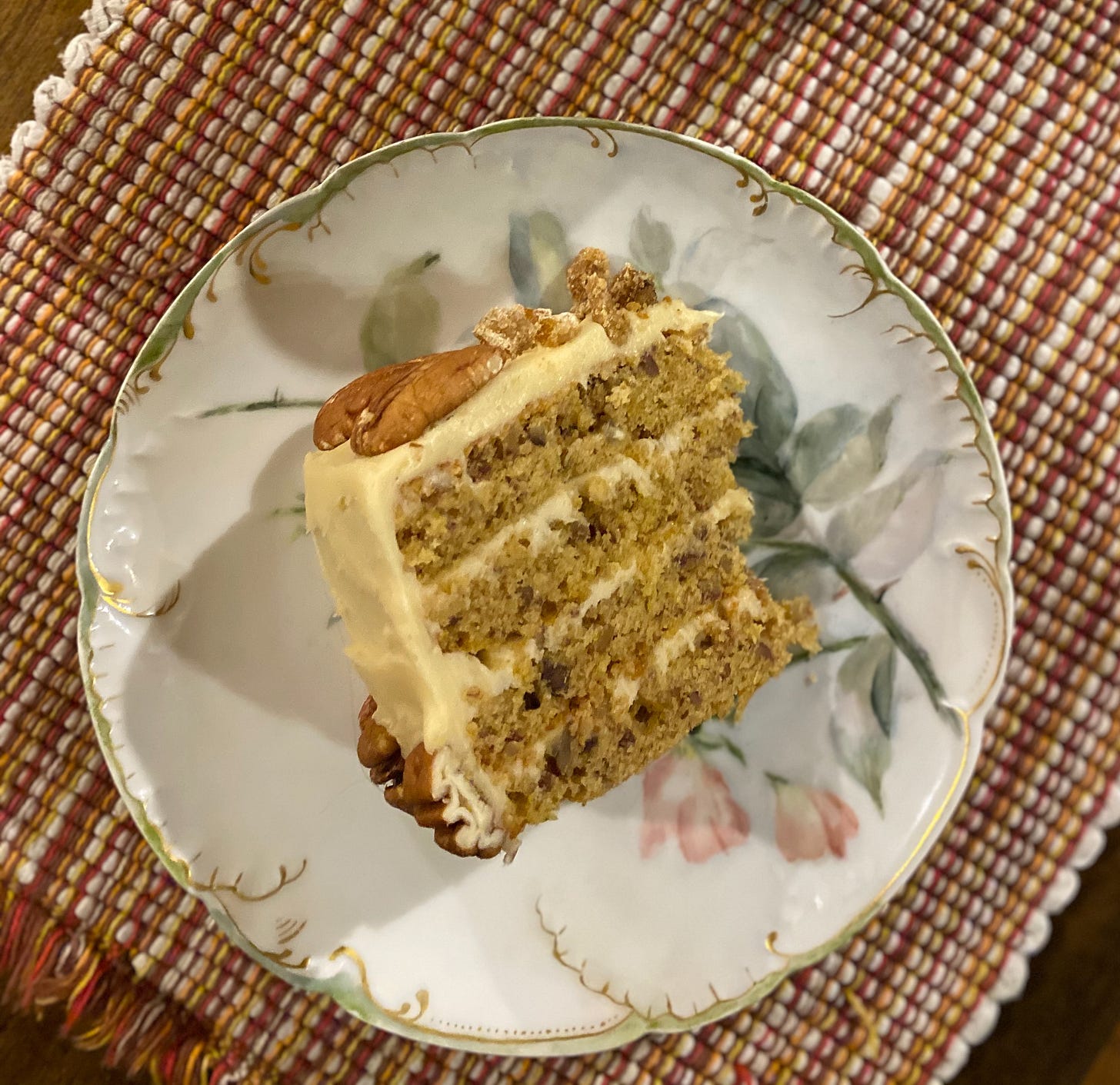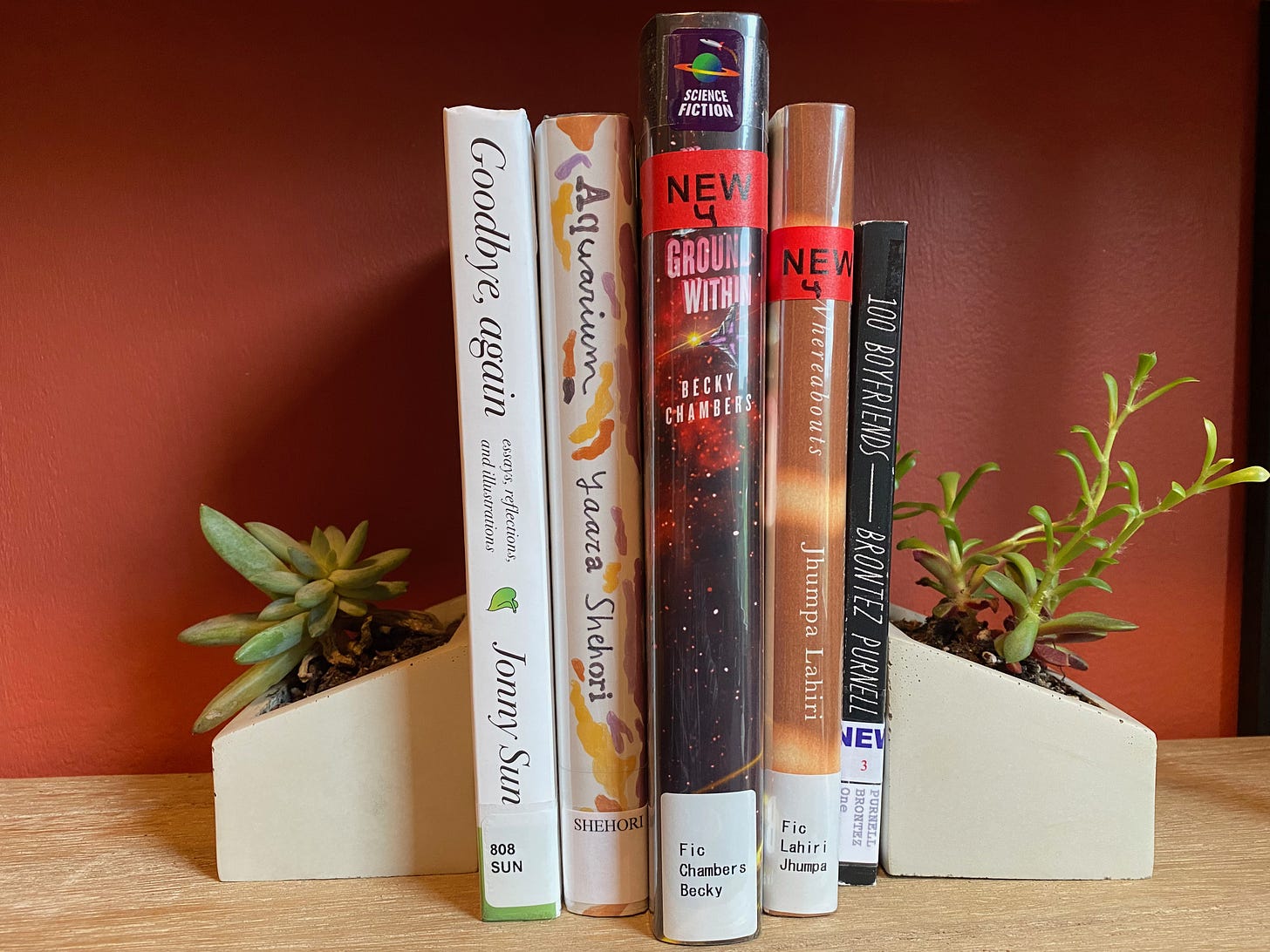Greetings, bookish friends! I wish I had some bird news to report, but it’s been a while since I’ve identified a new species. I did have six goldfinches on my feeder all at once recently, which was quite a sight. I do have this exciting update, though: the blueberries are coming!
So, books. For a long time, my brother and sister-in-law gave me the same Christmas present every year: a trip to hear the Boston Symphony Orchestra. I can still remember the first time I heard a symphony played in that concert hall, the way the music surrounded me, how it felt like a conversation between the musicians, their instruments, the composer, the space, and me. Symphony is a word with so many layers of meaning, literal and metaphorical. These three books embody many of those meanings. They are symphonies of many voices and experiences, blending and weaving and intermingling into new kinds of wholeness.
The Books

Backlist: Space Opera by Catherynne M. Valente (Science fiction)
Friends, this is a bizarro book. Even if you’re into sci-fi, it might not be for you. But if it is for you, well, I can only say that you are in for some true delight. Weird, WTF, “wow the human imagination is staggering” delight.
To set the stage: this novel takes place 100 years after the Sentience Wars, a grueling series of intergalactic wars that left the universe in shambles and nearly destroyed space-faring life. Nobody wanted to go through anything like that again, so the denizens of the universe came up with an alternative method for determining sentience: the Metagalactic Grand Prix. Once each cycle, all civilizations are required to participate in this intergalactic singing competition. If a civilization can’t prove their sentience via song/dance/performance art, they’re obliterated. Less casualties than all-out war but…high stakes.
Humankind has discovered the wider universe just in time for the next Metagalatic Grand Prix. They have to select a musican to represent Earth and save humanity from annihilation. So they pick Decibel Jones and the Absolute Zeroes, a washed-up glam rocker from London and his ragtag band. Yes, it’s as silly as it sounds.
The book follows Decibel and his bandmates as they head off-planet for the competition, desperately trying to come up with the right song. There’s some backstory about their lives and careers and the emotional messes they’ve gotten themselves into. But Valente is just as interested in the other competitors, and so the book is partly a historical and cultural encyclopedia of aliens. This is what makes it feel so symphonic. It reads like a riveting textbook about alien life. One of my favorite things about science fiction is the sheer volume of bizarre aliens that humans are capable of imagining. This book is a showcase of imagination, a collection of cultures, a tour through the histories and quirks and art and physiologies of some truly strange and often hilarious civilizations — including, of course, humanity.
To me, it felt like a love letter to music and a love letter to science fiction itself. It’s one of the weirdest and funniest books I’ve read in some time. I laughed out loud through most of it. It’s playful and silly and makes fun of itself constantly. Yet underneath all the glamor and glitter and humor, there’s a surprisingly moving story about what it means to belong to something beyond yourself. If you enjoy optimistic science fiction, can handle absurd space camp, and like silly stories with big hearts, this’ll be right up your alley.
I listened to it on audio; Heather Miller’s narration is masterful.
Frontlist: Four Hundred Souls: A Community History of African America edited by Ibram X. Kendi and Keisha N. Blain (History)
This ambitious and creative collection of essays is unlike any other history I’ve read. It’s truly symphonic in structure and tone. It’s a collection of distinct voices, writers with particular interests and viewpoints, each of whom add something to the whole. “[H]istories of Black America have almost always been written by a single individual, usually a man,” Kendi writes in the introduction. “But why not have a community of women and men chronicling the history of a community? Why not a Black choir singing the spiritual into the heavens of history?” This book is that choir. It’s comprised of the work of eighty Black writers, scholars, and historians, and ten Black poets.
I think it’s worth explaining how Kendi and Blain chose to structure this work, because the structure is what makes it both so cohesive and so exciting. Each writer covers a five-year span in this four hundred year history of Black America. The book itself is divided into ten sections, each covering forty years, and each section ends with a poem that captures some essential piece of those forty years.
It begins in 1619, with the arrival of twenty enslaved Africans in Jamestown, Virginia. As Kendi notes in the introduction, these were not the first African people to arrive in the Americas, but it is the first record of such an arrival. Nikole Hannah-Jones, Pulitzer-prize winning reporter and founder of The 1619 Project opens the book with an essay about the White Lion, the ship that arrived in North America a year before the Mayflower, carrying twenty enslaved Angolans, an event that has largely been forgotten. It ends with an essay by Black Lives Matter co-founder Alicia Garza, reflecting on the rise of BLM between 2014 and 2019. Between these two essays are dozens of fascinating and powerful explorations of people, places, ideas, movements, inventions, and more.
I’m not going to try to recount everything I learned in this book. It’s impossible to capture four hundred years of history in a single volume, and that’s not what this book sets out to do. Instead of a cohesive, comprehensive history, it’s a collection of what matters to these ninety Black writers. It’s a catalogue of what disturbs and fascinates them, what has lingered in their minds, what they cherish, what haunts them. It’s a living history. Though it’s told chronologically, it often doesn’t feel linear because each piece is so different in style, tone, and subject matter. The whole book is a series of windows, a collection of doors.
Ijeoma Oluo writes about how the 1630 whipping of Hugh Davis, a white man who slept with a Black woman, directly affects how we think about race today. She examines the legacy of whiteness and white purity, reflecting on her own identity as a Black woman with a white mother. Christoper J. Lebron writes about a petition against slavery written by a group of Philadelphia Quakers in 1688, holding it up as an example of “a quality that Black people need in white Americans—the uncompromising belief that what is wrong with racism is not that it inhibits full access to American goods and treasures but that it is an affront to the human standing of Black Americans.”
Sylviane A. Diouf writes about Maroon communities in the South in the 1720s. Nafissa Thompson-Spires writes about Lucy Terry Prince, who wrote the first known poetry by an African American in the mid 18th century. There are essays about Sally Hemings, Fredrick Douglas, the Fugitive Slave Act, and other well-known people and events. And there are essays about Black queer lives in the 1810s, the history of Black newspapers, the 1919 Chicago Race Riot, Black soldiers in World War II, and the Combahee River Collective. There are essays about slave revolts and Supreme Court cases and the history of medicine, artists. Each writer brings their own perspective to their subject, which makes the whole book feel like a dynamic conversation.
This is a book to linger over. I listened to the audio, which is outstanding. The full-cast recording makes it feel even more symphonic. But I also own a hard copy, and I’m glad I do, as I plan to return to it many times over.
Upcoming: Home of the Floating Lily by Silmy Abdullah (Short stories, Dundurn Press, 7/20)
I’m so immersed in the book world these days that it sometimes it feels like browsing the Netgalley catalog for upcoming review copies is the only way I still read books I know nothing about. This short story collection looked intriguing, so I dowloaded it on a whim, though I’d never heard of it. I’m so glad I did!
Short stories are naturally symphonic. This collection is centered around Bangladeshi characters, most of them immigrants living in one particular neighborhood in Toronto. They all have their own struggles and desires and quirks, but as a whole, this book paints a vivid picture of a diverse immigrant community. The stories echo each other; themes come up again and again in different guises. But the collection never feels stagnant or repetitive. It’s an elegantly woven tapestry. The stories build on each other, talk to each other. Each one is simply plotted. Abdullah’s prose is smooth and straightforward. There are no surprising structural choices. All the surprises are in the lives of the characters, and the decisions they make.
The stories themselves are about family and geography and diaspora. They deal with migration, poverty, isolation, Islamophobia, belonging. Many of them concern marriage and parenthood; family is central in almost every story. But often a story veered off in a direction I didn’t expect. A story that I thought was about a man and his wife turned out to be mostly about his relationship with his daughter. A complicated and wonderful story about a mother learning to let go of her expectations for her sons was as much about her own desires as it was about theirs. Abdullah has a knack for writing honestly about the intertwined threads of many different relationships.
She’s also adept at my favorite kind of short stories, ones that capture transformations, small but life-altering experiences. In “Across the Ocean” a college student returns to Bangladesh to visit her aunt and uncle, only to develop an intense friendship with the woman who cleans and cooks for them. In “Familiar Journey” two strangers share a moment of unexpected connection during an emergency on a train. There are many such moments of unexpectedness — characters often find understanding or betrayal or comfort where they don't expect to.
Abdullah is a Bangladeshi Canadian writer, lawyer, and activist. Her deep knowledge of the neighborhoods she explores in these stories comes through in every page, as does her compassion for her characters. Though many of the stories deal with familial discord, alienation, and racism, I found them easy to sink into. There’s an underlying warmth to the whole collection. It’s by turns joyful, bittersweet, sorrowful, and humorous. It’s out July 20th, and you can preorder it here.
The Bake
I know it’s June, which is not exactly the prime month for a warm, nutty, spice-laden cake. But this cake is such a symphony of flavors and textures! The recipe is adapted from The New Way to Cake by Benjamina Ebuehi (one of my favorite Bake Off contestants!) and the book is also a symphony of cakes. So, even though I made it a few months ago, I had to include it this week. Make it on a rainy day, or bookmark it to come back to in the fall. It is outrageously good.

Pecan & Burnt Honey Cake
Makes one 7” layer cake
Burnt honey is basically just caramelized honey. It adds a deep, smoky flavor to this delightfully nutty cake. Ginger and nutmeg add warmth, and spelt flour perfectly compliments the pecans. If you have some candied orange peel, it is divine here. But don’t worry if you don’t; it’s also delicious without.
Ingredients
For the cake:
100 grams all-purpose flour
90 grams spelt flour (if you don’t have a scale, use 1 1/2 cups total flour divided however you like; using just AP is also fine)
2 tsp baking powder
1 tsp dried ginger
1 tsp freshly grated nutmeg
1/2 tsp salt
1 stick (8 Tbs/115 grams) unsalted butter, at room temperature
200 grams (1 cup) toasted sugar
2 eggs
3/4 cup (180 ml) milk
2 tsp vanilla
100 grams (1 cup) pecans, toasted and finely chopped
For the frosting:
1 cup (150 ml) honey
2 sticks (16 Tbs/225 grams) unsalted butter
1/2 tsp salt
160 grams (1 1/3 cups) powdered sugar
1/4 cup (60 ml) milk
To finish:
50 grams (1/2 cup) pecans, to decorate
3/4 cup chopped candied orange peel
Make the cake: Preheat the oven to 350. Grease two 7” round cake pans and line the bottoms with parchment paper. (The original recipe calls for 6” pans; 7” pans was what I had and it worked fine.)
In a medium bowl, mix together both flours, ginger, nutmeg, salt, and baking powder. Set aside. In a stand mixer fitted with the paddle attachment, or with electric beaters, cream the butter and sugar until pale and creamy, 3-5 minutes. Add the eggs one at a time, beating after each addition. Add half the flour mixture, then the milk and vanilla, followed by the remaining flour. Scape down the sides of the bowl as needed. Fold in the chopped pecans with a rubber spatula.
Divide the batter evenly between the two pans. Bake for 30-35 minutes, until the tops are nicely browned and a toothpick inserted in the center comes out clean. Let the cakes cool for ten minutes, then turn them out on a wire rack. Once they’re completely cool, wrap them in plastic and stick them in the fridge.
Make the frosting: Heat the honey is a large saucepan over medium heat. Eventually, it will start to caramelize and turn a deep, dark brown. This will take a while! I took mine off the heat a bit too soon; it was still delicious, but you have to wait till the last possible second for that smoky, caramelized flavor. When it starts to smoke just a bit, it’s ready. Remove it from the heat and stir in the butter and salt. Let it cool to room temperature, then stick it in the fridge to firm up for an hour or so. When it’s cooled to the consistency of softened butter, transfer it to the bowl of a stand mixer, and beat for 3-5 minutes, until smooth. Add the powder sugar and continue beating to make a thick buttercream. If it’s too thick, add the milk a little bit at a time to loosen it. Return it to the fridge until you’re ready to use.
Assemble the cake: Remove the cooled cakes from the fridge. Use a serrated knife to even the tops, and then cut each cake into two thin layers. Place one layer on a cake board or plate. Add a scoop of buttercream and use an offset spatula to spread it evenly. If you’re using candied orange peel, scatter a handful on top of the frosting. Repeat with the next two layers. Place the last layer topside down to ensure a nice flat top.
Frost the sides and top of the cake with the rest of the buttercream, using a bench scraper or offset spatula to smooth as you go. If you’re feeling fancy, you can crumb coat it with a thin layer of frosting, stick in the fridge for 30 minutes, and then add a final layer. Decorate with pecan halves, more chopped candied orange peel, and/or a drizzle of honey. It’ll last at least a week in the fridge (good luck with that).

The Bowl and The Beat
The Bowl: Simplest Garlic Scape Pesto
I wanted to have a much more exciting recipe for you this week, because it is June! The veggies are pouring it! But making dinner of any kind has been a struggle recently, so this is what I have. I truly love living alone, but cooking for myself is hard sometimes. My fellow solo home-dwellers, this one is for you.

In a food processor, combine 2-3 bunches of roughly chopped garlic scapes (flower buds trimmed off), a handful of basil leaves, a handful of nuts (pine nuts, walnuts, or almonds), a big pile of grated Parmesan, a pinch of salt, and several glugs of olive oil. Puree until smooth, then taste and adjust seasoning/consistency to your liking. Meanwhile, cook some pasta. Two minutes before it’s done, add a few handfuls of sun-dried tomatoes. Drain and toss with the pesto. I added some goat cheese for extra creaminess.
The Beat: Mostly Dead Things by Kristen Arnett, read by Jesse Vilinsky

I absolutely loved With Teeth (it inspired a whole newsletter about queer motherhood), so I figured it was time to give Arnett’s first book a try. I’m not sure how I feel about it, even though I only have about an hour left. It’s defintley weird, just like everyone said. It’s about Jessa, a thirty-something woman whose family owns a taxidermy shop. After her father dies by suicide, she’s struggling to keep the shop afloat and her dysfunctional family alive.
I can see traces of With Teeth in this. It’s also about an unhappy family, about being stuck, about a queer woman making questionable choices. Arnett’s writing is visceral, especially her writing about bodies, which I honestly love (it’s weird and often gross, though). But I haven’t been able to connect with the book as a whole; listening to it, I feel a bit detached. It could be my state of mind. I am curious to see how it ends.
I do love the narrator. If this book sounds at all intriguing to you, I definitely recommend it on audio.
The Bookshelf
The Library Shelf
I’m in the middle of two library books: Eavesdropping: A Memoir of Blindness and Listening by Stephen Kuusisto and Burning Girls and Other Stories by Veronica Schanoes. I’m enjoying both. And I currently only have five outstanding holds! So, besides my super leggy succulents, I’m feeling good about the state of my library shelf.

The Visual
I’m moving in a few weeks, which means I’m currently packing up all my books. Yes, I definitely needed to make this huge pile of queer books as part of the packing process. Moving is horrible, but queer book piles are joy.
Around the Internet
On Book Riot, I wrote about the ten stories I’d want in my dream queer short story anthology.
Now Out
Hooray! The Natural Mother of the Child by Krys Malcolm Belc is now out! I reviewed this book back in April, and it is one of my favorite reads of the year. I’m excited to see that there’s an audiobook now, which Belc reads. The book is full of visuals — photos and annotated documents — and I can’t wait to see how it all translates to audio. I’m sure it’ll be incredible.
The Boost
Related to absolutely nothing (because that’s just how it is sometimes), I came across this recently and it’s been really useful for me. Click through the link to see the rest of the slides. There’s some fantastic information about wealth redistribution, budgeting for mutual aid, and thinking critically about how to donate money.
Image: An Instagram post from Pocket Change Pools. Black text on a pink-to-orange gradient background reads: How to Budget Sustainably for Mutual Aid. Why wealth distribution looks different for everyone, and how to best redistribute while sill looking out for yourself.
As always, a little bit of beauty to send you on your way: my river spot again. Words can’t express how grateful I am to live so close to this magic.

And that’s it until next week. Catch you then!







Re: mutual aid—Daniel Everett has been quoted by Charles Eisenstein and Robin Wall Kimmerer from a conversation he had with an indigenous Brazilian, who said, in reference to the surplus from a hunt, "I store my meat in the belly of my brother."
What if, instead of having savings accounts, we gave money away to others in our communities? This is also more "efficient" from the economic standpoint, as money that isn't circulating effectively doesn't exist.